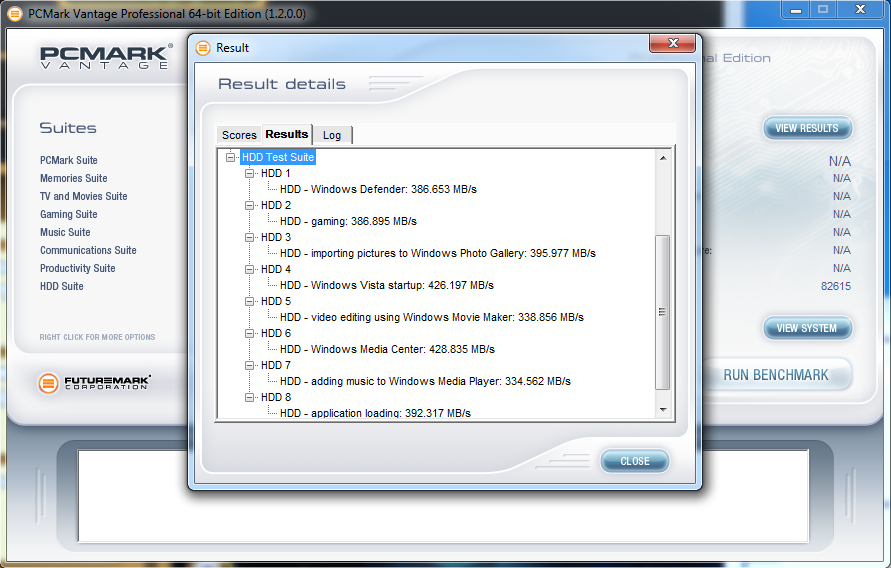The SSD Review uses benchmark software called PCMark Vantage x64 HDD Suite to create testing scenarios that might be used in the typical user experience. There are eight tests in all and the tests performed record the speed of data movement in MB/s to which they are then given a numerical score after all of the tests are complete. The simulations are as follows:
- Windows Defender In Use
- Streaming Data from storage in games such as Alan Wake which allows for massive worlds and riveting non-stop action
- Importing digital photos into Windows Photo Gallery
- Starting the Vista Operating System
- Home Video editing with Movie Maker which can be very time consuming
- Media Center which can handle video recording, time shifting and streaming from Windows media center to an extender such as Xbox
- Cataloging a music library
- Starting applications
SANDISK ULTRA II SSD PCMARK VANTAGE RESULTS
The SanDisk Ultra II 240GB SSD achieved a Total Score of 82,615 points. The highest transfer speed of 429MB/s was recorded during the “Windows Media Center” benchmark, while the lowest of 339MB/s was recorded during the “Windows Movie Maker” benchmark.
PCMARK 8 EXTENDED STORAGE WORKLOAD
For our last benchmark, we have decided to use PCMark 8 Extended Storage Workload in order to determine steady state throughput of the OCZ ARC 100. This software is the longest in our battery of tests and takes just under 18 hours per SSD. As this is a specialized component of PCMark 8 Professional, its final result is void of any colorful graphs or charts typical of the normal online results and deciphering the resulting excel file into an easily understood result takes several more hours.
There are 18 phases of testing throughout the entire run, 8 runs of the Degradation Phase, 5 runs of the Steady State Phase and 5 runs of the Recovery Phase. In each phase, several performance tests are run of 10 different software programs; Adobe After Effects, Illustrator, InDesign, Photoshop Heavy and Photoshop Light, Microsoft Excel, PowerPoint and Word, as well as Battlefield 3 and World of Warcraft to cover the gaming element.
- PRECONDITIONING -The entire SSD is filled twice sequentially with random data of a 128KB file size. The second run accounts for overprovisioning that would have escaped the first;
- DEGRADATION PHASE – The SSD is hit with random writes of between 4KB and 1MB for 10 minutes and then a single pass performance test is done of each application. The cycle is repeated 8 times, and with each time, the duration of random writes increases by 5 minutes;
- STEADY STATE PHASE – The drive is hit with random writes of between 4KB and 1MB for 45 minutes before each application is put through a performance test. This process is repeated 5 times;
- RECOVERY PHASE – The SSD is allowed to idle for 5 minutes before and between performance tests of all applications. This is repeated 5 times which accounts for garbage collection; and
- CLEANUP – The entire SSD is written with zero data at a write size of 128KB
For our PCMark 8 consistency testing the SanDisk Ultra II follows a similar trend as other drives. The Degrade and Steady State performance are similar, while the performance immediately increases in the Recovery stage. The lowest result recorded was 25MB/s for InDesign during Degrade 1. The highest result was 302MB/s in the fourth Recovery stage for the Photoshop Light testing. When compared to the consistency results from the SanDisk Extreme Pro, it is easy to see why the Extreme Pro has a price premium over the Ultra II.
 The SSD Review The Worlds Dedicated SSD Education and Review Resource |
The SSD Review The Worlds Dedicated SSD Education and Review Resource | 


> write speeds dropped to around 240MB/s. This is still pretty good,
especially considering it is such a compact design with only four TLC
NAND packages.
I wonder how other capacities perform. This kind of write is avarage at best, since even older 840 topped that.
But, if this is priced right, its a great alternative to MX100. Lets just hope this thing doesn’t have the same issues as 840 and 840EVO, as those drives experince quite a drop in read performance on cold files. Its actually an issue, that many have nowdays.
I wonder as well. And yes, I believe this drive is a great alternative to the MX100.
I have taken note of the 840 cold files issue when it first appeared as well, it is a little disappointing. Hopefully a simple F/W update can fix it. Otherwise, I am pondering if it could be a TLC NAND cause.
I suspect (again, i’m only making wild guesses here) it has to be TLC, since its only limited to 840/840evo, while 840pro is not affected. Given how many states TLC must hold and very small litography its quite possible, that data retention is dropping faster than we though. Or it could be something entirely different.